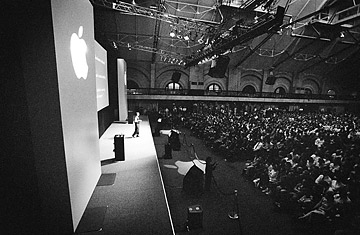
Boston's 1997 MacWorld Expo listens to Jobs on stage.
(2 of 7)
Jobs was only 21 when he started Apple--officially formed on April Fools' Day 1976--with his buddy Steve "Woz" Wozniak, a self-taught engineer of rare talents. (A third founder, Ronald Wayne, left after less than two weeks.) Jobs already had a lot of experience, though not the kind you usually think of as preparation for building a company. He'd spent one unhappy semester at Reed College in Portland, Ore., and 18 happy months of "dropping in" on Reed classes as he saw fit. (He audited a class on calligraphy, which shows in the gorgeous fonts of every Apple product he ever shipped.) He'd worked low-level Jobs at Silicon Valley icons HP and Atari; he would often claim, appropriately but not unassailably, to have created the original version of the seminal game Breakout. He'd taken a spiritual journey to India and dabbled with psychedelic drugs and primal-scream therapy.
Woz, a technical genius of the first order, built computers because he loved them. Jobs wanted to sell them. Their first creation, the Apple I, was mostly a warm-up act for the Apple II in 1977. The insides of the II were the product of Woz's engineering genius, but much about the computer--from its emphasis on ease of use to its stylish case design--reflected the first stirrings of Jobs' keen instincts. In an era when most computers still looked like high school science projects, the Apple II was a consumer-electronics device--and a best seller.
In 1981, Woz crashed his V-tail Beechcraft Bonanza and spent months recuperating, and he returned to Apple only nominally thereafter. From then on, Jobs was the Steve who shaped Apple's destiny. In 1979 he visited Xerox's PARC research lab in Palo Alto, Calif., and was dazzled by what he saw there, including an experimental computer with a graphical user interface and a mouse. "Within 10 minutes ... it was clear to me that all computers would work this way someday," he later said. It was a moment he would repeat again and again in his career: Jobs did not invent things, but he recognized their power before anyone else did. He knew what Xerox had better than that company did, and he plundered it gleefully.
At Apple, PARC's ideas showed up first in the Lisa, a $10,000 computer that flopped. They reappeared in improved form in 1984 in the shape of the Macintosh, the creation of a dream team of gifted young software and hardware wizards led by Jobs. He launched it with an unforgettable Super Bowl commercial directed by Ridley Scott that represented the IBM-PC status quo as an Orwellian dystopia. Jobs dubbed the $2,495 Mac "insanely great," a bit of self-praise that became forever associated with him and Apple.
Jobs was right--but the Mac was also deeply flawed. The original version had a skimpy 128 KB of memory and no expansion slots. Computing pioneer Alan Kay, who worked at Apple at the time, ticked off Jobs by calling it "a Honda with a one-gallon gas tank." It didn't matter. Jobs had had an insight that the rest of the world is still catching up to and one that somebody with a proper engineering background would never have had: design is more important than functionality. All the horsepower in the world is useless if you can't figure out how to use it--and look good doing it.
